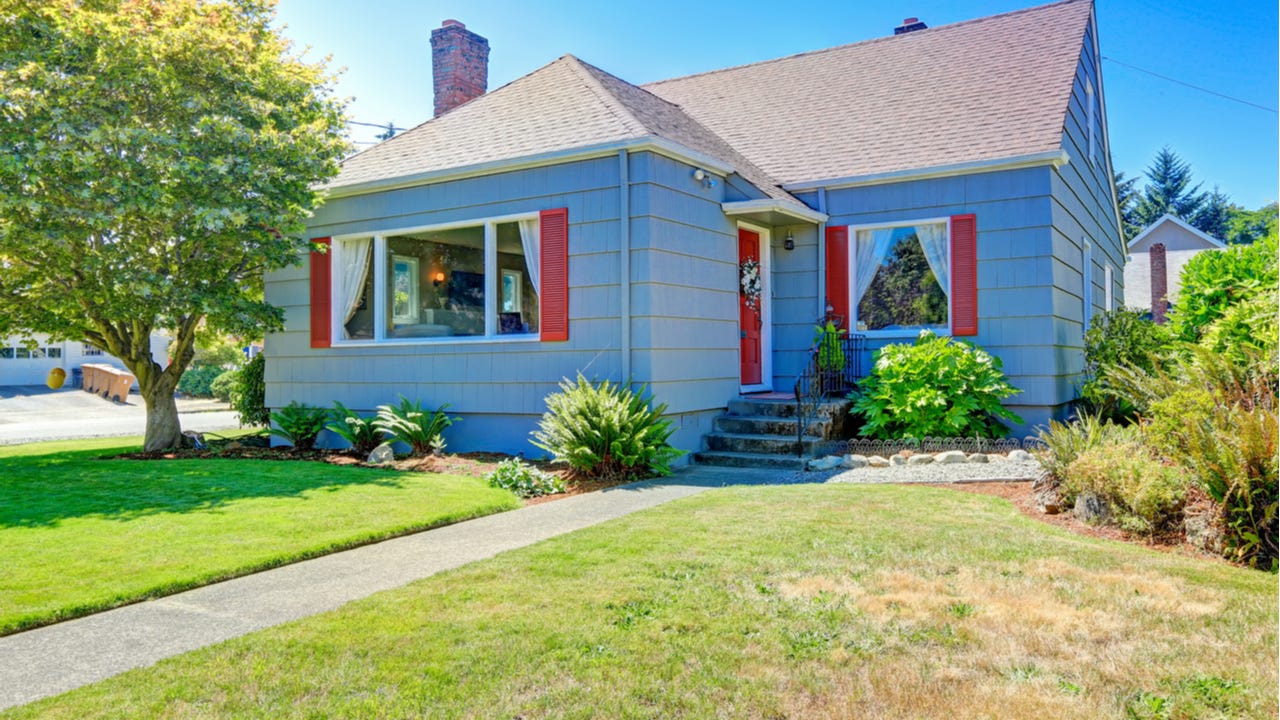What is mortgage amortization?

Key takeaways
- Mortgage loan amortization refers to the process of how you repay your mortgage balance over the loan term.
- At the beginning of your loan, a larger portion of your payment is put toward interest, but this reverses as your loan matures.
- You can use your amortization schedule to come up with the best repayment strategy for your needs.
What is mortgage amortization?
Mortgage amortization describes the process in which a borrower makes installment payments to repay the balance of the loan over a set period. These payments are divided between principal, or the amount borrowed, and interest, or what the lender charges to borrow the funds.
The longer the loan amortization period, the lower your monthly payment. That’s because the longer you spread out your payments, the less it will cost you each month, simply because there’s more time to repay.
The downside to a longer loan term, however, is more money spent on interest. In addition, because the interest payments are frontloaded with a longer mortgage, it takes more time to reduce the principal and build equity in your home — a factor to consider when comparing your loan options.
How amortization works with fixed-rate mortgages
With a fixed-rate mortgage, the monthly payments remain the same throughout the loan’s term. However, each time you make a payment, the amount of your payment that goes to the principal differs from the amount that gets applied to interest, even though you make each payment in equal installments.
“As your loan matures, you can expect a higher percentage of your payment to go toward the principal, with a lower percentage going toward the interest,” says Nishank Khanna, chief marketing officer at Clarify Capital in New York City.
How amortization works with adjustable-rate mortgages
On the other hand, an adjustable-rate mortgage (ARM) comes with a fixed interest rate for an initial period (usually between three and 10 years). After that, your rate — and, therefore, your monthly mortgage payment — will change every six or 12 months, depending on the type of ARM you have.
Like fixed-rate mortgages, you’ll pay a bigger chunk toward the interest at first. Over time, this will shift, so more of your payment will go toward the loan principal.
Mortgage amortization key terms
- Amortization schedule
-
A mortgage amortization schedule is a list of all the payment installments and their respective dates, most easily made with an amortization calculator. You might find your mortgage amortization schedule by logging into your lender’s portal or website and accessing your loan information online. But in some cases, you may need to contact your lender to request it.
How do you calculate mortgage amortization?
It’s best to use a loan amortization calculator to understand how your payments break down over the life of your mortgage.
You can use Bankrate’s amortization calculator to find out what your loan amortization schedule will be based on the loan terms you input. To use the calculator, you’ll need to input a few details about your mortgage, including:
- Principal loan amount
- Loan term (such as 30 years)
- Loan start date
- Interest rate
You also need to enter details about how often you make extra payments and the amount of those extra payments. The calculator provides an in-depth schedule for each month of your loan with details such as how much principal and interest you’ll pay in any given payment and how much principal and interest will have been paid by a specific date.
Mortgage amortization schedule example
Let’s assume you took out a 30-year mortgage for $400,000 at a fixed interest rate of 6.7 percent. At those terms, your monthly mortgage payment (principal and interest) would be about $2,581, and the total interest over 30 years would be $529,200.
Here’s a snippet of what your loan amortization schedule in this example would look like in the first year of the loan term (assuming you got the loan in 2025):
| Year | Month | Payment | Principal | Interest | Balance | Total Interest | Total Principal |
| 2025 | February | $2,581 | $347.78 | $2,233.33 | $399,652.22 | $2,233.33 | $347.78 |
| 2025 | March | $2,581 | $349.72 | $2,231.39 | $399,302.50 | $4,464.72 | $697.50 |
| 2025 | April | $2,581 | $351.67 | $2,229.44 | $398,950.83 | $6,694.16 | $1,049.17 |
| 2025 | May | $2,581 | $353.64 | $2,227.48 | $398,597.19 | $8,921.64 | $1,402.81 |
| 2025 | June | $2,581 | $355.61 | $2,225.50 | $398,241.58 | $11,147.14 | $1,758.42 |
| 2025 | July | $2,581 | $357.60 | $2,223.52 | $397,883.98 | $13,370.66 | $2,116.02 |
| 2025 | August | $2,581 | $359.59 | $2,221.52 | $397,524.39 | $15,592.18 | $2,475.61 |
| 2025 | September | $2,581 | $361.60 | $2,219.51 | $397,162.79 | $17,811.69 | $2,837.21 |
| 2025 | October | $2,581 | $363.62 | $2,217.49 | $396,799.17 | $20,029.18 | $3,200.83 |
| 2025 | November | $2,581 | $365.65 | $2,215.46 | $396,433.52 | $22,244.64 | $3,566.48 |
| 2025 | December | $2,581 | $367.69 | $2,213.42 | $396,065.83 | $24,458.06 | $3,934.17 |
Here’s what your amortization schedule would look like in the final year:
| Year | Month | Payment | Principal | Interest | Balance | Total Interest | Total Principal |
| 2054 | January | $2,581 | $2,400.89 | $180.22 | $29,877.95 | $528,104.9 | $370,122.05 |
| 2054 | February | $2,581 | $2,414.29 | $166.82 | $27,463.66 | $528,271.72 | $372,536.34 |
| 2054 | March | $2,581 | $2,427.77 | $153.34 | $25,035.89 | $528,425.06 | $374,964.11 |
| 2054 | April | $2,581 | $2,441.33 | $139.78 | $22,594.56 | $528,564.84 | $377,405.44 |
| 2054 | May | $2,581 | $2,454.96 | $126.15 | $20,139.60 | $528,690.99 | $379,860.40 |
| 2054 | June | $2,581 | $2,468.67 | $112.45 | $17,670.94 | $528,803.44 | $382,329.06 |
| 2054 | July | $2,581 | $2,482.45 | $98.66 | $15,188.49 | $528,902.10 | $384,811.51 |
| 2054 | August | $2,581 | $2,496.31 | $84.80 | $12,692.18 | $528,986.91 | $387,307.82 |
| 2054 | September | $2,581 | $2,510.25 | $70.86 | $10,181.93 | $529,057.77 | $389,818.07 |
| 2055 | October | $2,581 | $2,524.26 | $56.85 | $7,657.67 | $529,114.62 | $392,342.33 |
| 2054 | November | $2,581 | $2,538.36 | $42.76 | $5,119.31 | $529,157.37 | $394,880.69 |
| 2054 | December | $2,581 | $2,552.53 | $28.58 | $2,566.78 | $529,185.96 | $397,433.22 |
| 2055 | January | $2,581 | $2,566.78 | $14.33 | $0.00 | $529,200.29 | $400,000 |
As shown in this amortization table for a mortgage, the amount of your payment that’s allocated to the principal increases as the mortgage moves toward maturity, while the amount applied to interest decreases.
Note that this is the case for a typical 30-year fixed-rate mortgage. Amortization schedules — and how the payment is distributed to the interest and principal — can vary based on factors like how much you’re borrowing and your down payment, the length of the loan term and other conditions. Using Bankrate’s calculator can help you see what the outcomes will be for different scenarios.
What should borrowers know about mortgage amortization today?
When deciding on a loan term and amortization, it’s important to consider how long you plan to remain in the home.
“Say, for example, you purchased a starter home intending to live in it for only five years before upgrading to a larger house,” says Khanna. “You expect to make a profit when you sell, but you find out that you owe more than the value of the house. That’s because of your chosen amortization schedule and a slight depreciation [in the] home’s value. In this scenario, you opted for a 30-year mortgage over a 15-year loan, and most of your payments went toward interest rather than the principal balance.”
Understanding your amortization schedule can also help you determine if you need to change your repayment strategy, especially if you’re struggling to make payments.
“For those who may be facing challenges paying their mortgage each month, you can, for instance, discuss options with your lender that include refinancing your mortgage or only paying a portion of the debt owed each month,” says David Druey, Florida regional president of Miami-based Centennial Bank.
You might also be considering prepaying your mortgage or paying off your loan ahead of time. If you can afford to make extra payments on your mortgage, you’ll lower your principal balance faster and reduce the amount of interest you pay on your loan.
For example, let’s say you have a $200,000, 30-year loan with a 6.5 percent interest rate. By making an extra $100 payment each month, you would save $55,944 in interest over the life of your mortgage. You’d also pay off your loan five years and seven months earlier than if you didn’t make the extra payment.







